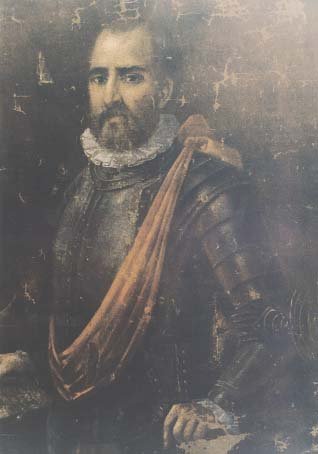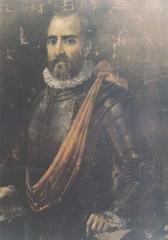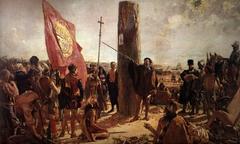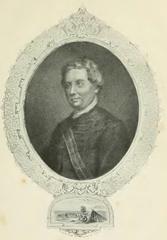
Juan de Garay Buenos Aires Visiting Hours, Tickets, and Historical Sites Guide
Date: 14/06/2025
Introduction to Juan de Garay and His Significance
Buenos Aires, Argentina’s dynamic capital, is a city where layers of indigenous heritage, colonial ambition, and multicultural influences converge. Central to the city’s identity is Juan de Garay, the Spanish conquistador who orchestrated the second—and permanent—foundation of Buenos Aires in 1580, transforming a transient outpost into a thriving colonial center on the Río de la Plata. Garay’s vision and strategic urban planning laid the groundwork for Buenos Aires to become a gateway to South America and a hub of Spanish colonial administration (Wikipedia; buenosaires.com).
Long before the Spanish arrived, indigenous peoples like the Querandíes inhabited the Pampas, shaping the land and resisting European encroachment. The first Spanish settlement by Pedro de Mendoza in 1536 was short-lived due to resilient indigenous opposition and resource scarcity, highlighting complex colonial dynamics (city-data.com).
Today, visitors can explore historic sites that illuminate this legacy, such as Plaza de Mayo—the political and historical nucleus where Garay’s expedition landed—and the Plazoleta 11 de Junio de 1580, commemorating the city’s second foundation. These landmarks reveal both the Spanish colonial grid system and the syncretic culture that defines Buenos Aires (Waymarking.com).
This guide delivers practical information on key Juan de Garay-related sites—visiting hours, ticketing, accessibility, and travel tips—while highlighting nearby attractions like San Telmo and Puerto Madero. Whether you’re passionate about history or a casual traveler, delving into Juan de Garay’s story and the city’s indigenous roots will enrich your Buenos Aires experience (Patagonia-Argentina.com; lanueva.com).
Early Settlement and the First Foundation
Buenos Aires’ roots stretch to the early 16th century when Spanish explorers, seeking to control the Río de la Plata, attempted their first settlement. Pedro de Mendoza founded Nuestra Señora Santa María del Buen Aire in 1536, but the fledgling colony collapsed due to food shortages and protracted conflicts with the Querandíes, underscoring the region’s challenging dynamics (buenosaires.com). For nearly 45 years, the area returned to indigenous control, leaving a gap before the city’s lasting foundation.
Juan de Garay: Background and Rise to Prominence
Juan de Garay (1528–1583), a conquistador of Basque origin, migrated to the Americas in 1543, participating in expeditions in Peru and Bolivia. By 1568, he had settled in Asunción (Paraguay), rising to political prominence and eventually becoming governor. Garay’s tenure emphasized order, the founding of settlements, and the creation of governance systems. His progressive administrative approach included founding Indian villages and incorporating local forms of governance (Wikipedia).
The Second Foundation of Buenos Aires (1580)
In 1580, under orders from the Spanish Crown, Garay led an expedition from Asunción to re-establish Buenos Aires as Ciudad de la Trinidad, with its port named Santa María de Buenos Ayres. On June 11, Garay and his settlers landed at the present-day Plaza de Mayo, marking the city’s definitive foundation (Wikipedia; buenosaires.com). He implemented the Spanish grid plan, centering the city around a main plaza—now Plaza de Mayo—a model for future colonial cities (argen-travel.com).
The strategic location enabled control over trade routes into the continent’s interior, sealing Buenos Aires’ importance as a Spanish port and administrative center.
Indigenous Context and Interactions
The region’s indigenous peoples, including the Querandíes and Guaraníes, influenced the fate of early European settlements. The first Spanish outpost failed largely due to indigenous resistance (buenosaires.com). While Garay’s governance included attempts at peaceful integration and local administration, broader colonization brought conflict, displacement, and the imposition of European social structures (Wikipedia).
Plaza de Mayo: Birthplace of Buenos Aires and Visitor Information
Plaza de Mayo, the site of Garay’s landing and the city’s heart, is surrounded by the Casa Rosada, Metropolitan Cathedral, and the Cabildo. Over centuries, it has evolved from colonial plaza to the epicenter of Argentina’s political life (historyhit.com).
Visiting Hours and Tickets
- Plaza de Mayo: Open 24/7, free entry.
- Casa Rosada Museum: Tuesday–Sunday, 10:00 AM–6:00 PM, free (online booking recommended).
- Cabildo Museum: Tuesday–Sunday, 10:00 AM–6:00 PM, ARS 100 (discounts for students/seniors).
- Metropolitan Cathedral: Daily, 7:00 AM–7:00 PM, free entry.
Travel Tips and Accessibility
Accessible via subway (Line A, Plaza de Mayo station) and several bus lines. The area is pedestrian-friendly, with ramps and accessible facilities at most major attractions. Guided walking tours are widely available, focusing on the city’s colonial roots and Garay’s legacy.
Unique Visitor Experiences
- Guided historical tours around the plaza and colonial buildings.
- Prime photo spots: Pirámide de Mayo, Casa Rosada, and the Cabildo.
- Witnessing civic demonstrations and cultural events—Plaza de Mayo remains a vibrant public forum.
Nearby Attractions
- San Telmo: Known for colonial architecture, tango, and antique markets.
- Puerto Madero: A revitalized waterfront with museums, restaurants, and scenic walks.
- Catedral Metropolitana: The city’s main cathedral, rich in art and history.
Garay’s Legacy and the Growth of Buenos Aires
Garay’s foundation catalyzed Buenos Aires’ transformation into a major port and urban center, its fortunes tied to transatlantic trade and Spanish colonial administration. The city’s grid plan and central plaza, established under Garay, remain defining features (buenosaires.com).
His influence extended beyond Buenos Aires—Garay also founded Santa Fe de la Vera Cruz and contributed to the development of other settlements along the Paraná River (Wikipedia).
The Fate of Juan de Garay
Garay’s life ended in 1583 when his party was ambushed by Querandíes near the Carcarañá River. He, a Franciscan priest, a woman, and twelve soldiers were killed (Wikipedia). His contributions are commemorated citywide through monuments, plazas, and place names.
Colonial and European Influences
Buenos Aires developed as a crossroads of Spanish, Italian, German, and British influences, especially after the Bourbon Reforms of the 18th century. This multicultural influx is reflected in the city’s architecture, neighborhoods, and cultural life (buenosaires.com).
Plazoleta 11 de Junio de 1580 and the Monument to Juan de Garay
The Plazoleta 11 de Junio de 1580, in the Monserrat district, marks the date of Buenos Aires’ second foundation. Its centerpiece, the Monument to Juan de Garay, was crafted by German sculptor Gustav Heinrich Eberlein and inaugurated in 1915 (Waymarking.com; Argentina.gob.ar). The bronze statue depicts Garay in conquistador attire, pointing to the ground to symbolize the city’s foundation. The granite base features bas-reliefs of Buenos Aires in 1580 and 1915.
- Access: Open 24/7, free entry.
- Location: Monserrat, near Casa Rosada—easily walkable from Plaza de Mayo.
- Best Time to Visit: Daytime for safety and optimal viewing.
Plaza Garay
Plaza Garay, in Constitución, honors Juan de Garay’s legacy. Once known as “Hueco de los Sauces,” it evolved alongside the city, reflecting urban and social changes (Plazas de Buenos Aires). Though not featuring a major monument, it offers local atmosphere and insight into everyday Buenos Aires.
- Access: Open to the public at all hours; best visited during the day.
- Location: Constitución neighborhood, accessible via train, subway, or bus.
Additional Sites of Interest
- Casa Rosada Museum: Adjacent to Plaza de Mayo, explores Argentina’s political and urban history. Open Tuesday–Sunday, 10:00 AM–6:00 PM, free entry (GPSmyCity).
- Metropolitan Cathedral: Located on Plaza de Mayo, it stands where the city’s first church was built. Open daily, free entry (World Guides).
Practical Tips for Visitors
- Language: Spanish is primary; many museums/tours offer English options.
- Safety: Central areas are safe by day; be vigilant against pickpocketing.
- Photography: Permitted in public spaces; check museum policies.
- Accessibility: Most central sites are wheelchair accessible, though streets may have uneven pavement.
- Guided Tours: Enhance your visit with a historical walking tour (GPSmyCity).
Exploring Juan de Garay’s Buenos Aires: Historical Context and Modern Experience
Indigenous Presence and Colonial Encounters
Before colonization, the Pampas were home to the Querandíes, whose resistance thwarted the first Spanish settlement (city-data.com). Garay’s 1580 settlement included a diverse group of settlers, some of indigenous and mixed descent, though only Spanish founders were officially recognized (lanueva.com).
Cultural Syncretism and Social Structure
Colonial Buenos Aires saw a blending of Spanish and indigenous cultures, visible today in local traditions, language, cuisine, and arts (mexicohistorico.com). The city’s grid plan and social hierarchy were shaped by Spanish law but adapted through local realities, with intermarriage and cultural exchange prevalent (city-data.com).
Enduring Legacies
Despite displacement and decline, indigenous heritage persists in place names, folklore, and the national figure of the gaucho—an emblem of Spanish-indigenous fusion (lanueva.com).
Visiting Juan de Garay’s Historical Sites: Hours, Tickets, and Tips
- Plazoleta 11 de Junio de 1580: Open daily, 8:00 AM–8:00 PM, free, wheelchair accessible.
- Museo Histórico Nacional: Tuesday–Sunday, 11:00 AM–6:00 PM, ARS 200 (discounts and free on Sundays), accessible (museum website).
- Guided Walking Tours: Book in advance online; cost around ARS 1500 per person.
- Cultural Events: Foundation anniversary (June 11) features commemorative events at Plazoleta 11 de Junio de 1580.
Navigating Buenos Aires: Transportation and Neighborhoods
- Public Transit: Use the SUBE card for subway, bus, and train (Vamos Spanish).
- Taxis/Rideshares: Safe and plentiful; recommended at night (Worldly Adventurer).
- Neighborhoods: San Telmo (historic), Palermo (nightlife), Recoleta (elegant/safe), Microcentro (central/historic) (Secrets of Buenos Aires).
Money, Dining, and Practicalities
- Currency: Argentine Peso (ARS); use official exchange and avoid “dólar blue” (Secrets of Buenos Aires).
- Payments: Cards accepted in most places; carry cash for small shops.
- Dining: Late dinners common; casual attire; use Type C/I plugs (Short Girl On Tour).
Health, Safety, and Cultural Etiquette
- Best Visit Periods: Spring (Oct–Nov) and autumn (Feb–Apr) (Secrets of Buenos Aires).
- Safety: Beware pickpockets, especially in crowds (Travel Safe Abroad).
- Emergency Numbers: 911 (police), 107 (medical), 100 (fire).
- Etiquette: One-cheek kiss customary; respect local customs at historical sites.
Frequently Asked Questions
Q: What are the visiting hours for Juan de Garay monuments?
A: Most monuments, such as Plazoleta 11 de Junio de 1580, are accessible daily from early morning to evening. Museums typically close Mondays.
Q: Are tickets required for historical sites?
A: Most outdoor monuments and plazas are free. Museums and some tours require tickets—purchase online when possible.
Q: What’s the safest neighborhood for history-focused travelers?
A: San Telmo and Microcentro offer proximity to historic sites; Recoleta and Palermo are also safe.
Q: Are guided tours available?
A: Yes, many guided tours in English and Spanish include Juan de Garay-related sites.
Q: Is Buenos Aires safe for solo travelers?
A: Yes, especially in central and well-patrolled neighborhoods. Use basic safety precautions.
Visuals and Media
For a more immersive experience, include photos of Plaza de Mayo, the Juan de Garay Monument, San Telmo’s colonial streets, and relevant museums (alt tags: “Juan de Garay Monument in Buenos Aires” and “Plaza de Mayo historical center”).
Internal and External Links
- Top Attractions in Buenos Aires
- Guided Tours in Buenos Aires
- Official Buenos Aires Tourism Website
- Casa Rosada Museum
Summary and Visitor Recommendations
Discovering Buenos Aires through Juan de Garay’s legacy is a journey into the city’s origins, its indigenous roots, and its cosmopolitan evolution. Sites like Plazoleta 11 de Junio de 1580, Plaza de Mayo, and surrounding neighborhoods provide accessible and meaningful ways to engage with this history (Argentina.gob.ar; Waymarking.com). With reliable transportation, free or low-cost entry, and a wealth of guided experiences, travelers can immerse themselves in layers of culture and history. For the most up-to-date information and enhanced experiences, the Audiala app is recommended.
Juan de Garay’s influence endures not just in monuments but in the living culture of Buenos Aires—a city where the past and present vibrantly coexist (Patagonia-Argentina.com; GPSmyCity).
Sources and Further Reading
- Juan de Garay, Wikipedia
- The Foundations of Buenos Aires, buenosaires.com
- Juan de Garay Monument, Argentina.gob.ar
- Juan de Garay Monument, Waymarking.com
- History of Buenos Aires, Patagonia-Argentina.com
- Juan de Garay Foundation Anniversary, lanueva.com
- Buenos Aires History, city-data.com
- Buenos Aires Walking Tours, GPSmyCity
































































































































































